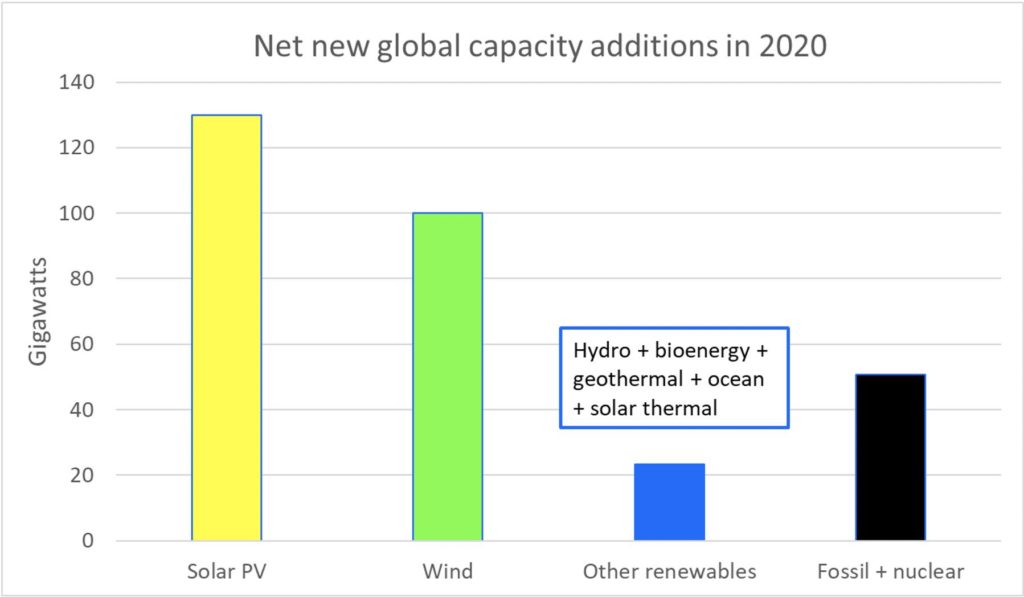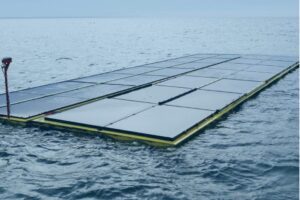There is a superhighway to rapid elimination of 80% of Australian greenhouse emissions. It uses mature, low-cost, reliable technology from vast production runs. Neither new technology nor taxes are needed. And it will cost approximately nil.
To get onto this superhighway, we need to electrify everything: we accelerate the already-rapid growth of solar and wind to displace coal and gas from electricity generation; we move to electric vehicles to displace oil; and we use electric heating to displace gas.
The deployment of solar and wind needs to double from 7 gigawatts in 2020 to 15 gigawatts per year. This is relatively straightforward considering that the deployment rate of solar and wind in 2015 was only 1 Gigawatt, and that prices continue to fall.
Australia has declining electricity emissions and declining electricity prices because cheap solar and wind energy is replacing more expensive electricity from coal and gas burning. Deep emissions reductions will have low or zero net cost.
No new technology is required to reduce emissions by 80%, although continuing technical development will yield ever lower energy costs. However, eliminating the last 20% of emissions will require substantial research, development and industrialisation.
These stubborn areas are aviation, shipping, the chemical and metals industry and the land sector.
Large-scale deployment of new transmission is urgently required to bring the new solar and wind power to the cities and to strengthen interstate connections. The Commonwealth Government should develop a National Transmission Network (NTN, by analogy with the NBN).
Australia is already a pathfinder for the ¾ of humanity who live in the sunbelt (below 35° of latitude) where most of the world’s growth in population, energy use and greenhouse emissions are occurring.
Australia is installing solar and wind 3-5 times faster per capita than the USA, China, Japan and Europe.
The economics of PV and wind are compelling. Australia is demonstrating that rapid deployment of solar and wind leads to declining emissions and low electricity prices.

In 2020, new solar and wind capacity was 10 times larger than net new hydro and coal capacity and 100 times larger than net new nuclear, carbon capture & storage, bioenergy, geothermal, solar thermal and ocean energy generation capacity.

The key low emission technologies are:
- Generation: solar and wind constituted ¾ of global net generation capacity additions in 2020 (and 99% in Australia). The International Energy Agency recently declared that “For projects with low cost financing that tap high quality resources, solar PV is now the cheapest source of electricity in history”.
- Storage: pumped hydro and batteries constitute 99% of the global storage market
- Transmission: to bring the new solar and wind power to the cities;
- Demand management: many methods are already in use to reduce demand during stress periods for the electricity grid;
- Land transport: global electric vehicles sales are more than 10 million and growing rapidly;
- Low temperature air and water heating: billions of reverse-cycle air conditioners and electric heat pump hot water systems have been sold;
- High temperature electrical heating for industrial processes: a wide variety of methods are already in use;
- Waste: high temperature incinerators are readily available that remove methane leakage and operate safely without hazardous emissions
Together, these technologies eliminate emissions from electricity, transport, heating and waste, which account for more than 70% of the total. Fugitive emissions of methane from coal and gas mining accounts for another 10% and phase out when fossil fuel exports are phased out.
Hydrogen has only a tiny role to play in the energy sector because of low (25%) storage efficiency. Electrification is by far the market leader in decarbonizing electricity, transport and heating.
However, hydrogen has an important role in decarbonizing the chemical industry in the 2030s (for which hydrogen atoms are required for chemical compounds).
Carbon capture and storage has been deployed at miniscule scale (apart from enhancing oil and gas extraction). Extravagant and unlikely growth rates and cost reductions would be required for it to play a significant role before 2040.
While net zero emissions in 2050 is essential, its actually more important to make deep cuts by 2030.
Australia can readily match the 2030 emissions reduction pledge of the United States of America, which is broadly in line with pledges by the European Union and the United Kingdom. Emissions would need to fall from 500 Megatonnes (Mt) in 2020 to 300 Mt in 2030:
- 90% of electricity generation should be renewable (mostly solar and wind) in 2030 (which achieves ¾ of the required reductions);
- 90% of new sales of vehicles and heating equipment should be electric in 2027.
Inconvenience arising from achievement of a 300 Mt target is minimal. Life proceeds as normal for most people. Solar and wind are already cheaper than coal and gas and continue to fall in price.
The whole-of-life cost difference between electric and fuelled vehicles will be gone by 2027. Electric air and water heating systems are already cost competitive with gas heating. Gas heating in industry is likely to decline.
Removal of fossil fuels from the economy confers many benefits in addition to mitigation of climate change: an end to coal mining, coal dust, black lung, coal mine fires, power station explosions, power station exhausts, power station ash, gas fracking, oil drilling, oil spills, oil imports, oil-related warfare, car exhausts and most urban smog.
Millions of solar and wind generators confer robustness on the Australian energy system in the face of challenges from extreme weather, trade disruption, pandemics, terrorist attacks and warfare.
Rapid, deep and cheap cuts to greenhouse emissions are much easier than most people think. They will cause minimal disruption and have much lower cost than the effects of COVID-19 or climate change.
Professor Andrew Blakers is from the School of Engineering, College of Engineering and Computer Science, at the Australian National University.










